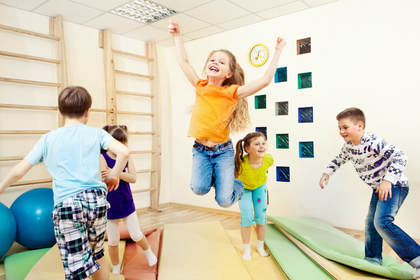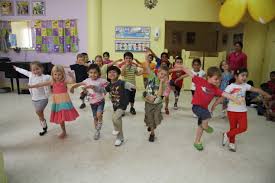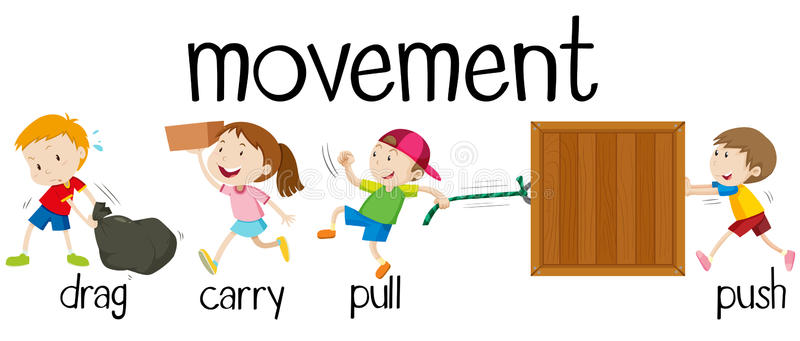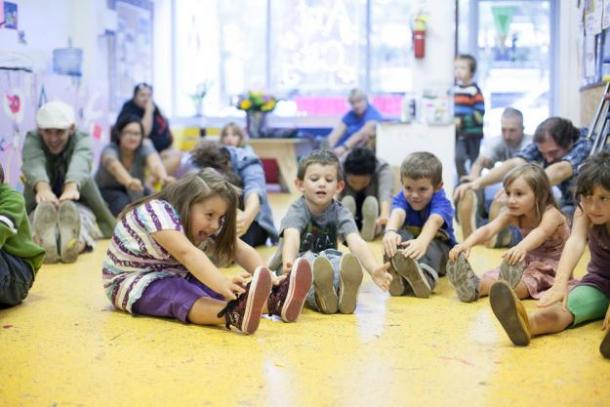RESEARCH ABOUT MOVEMENT IN THE CLASSROOM
|
There has been a push for schools to decrease play time to increase academics. This purpose of the movement was to increase student learning time, creating more intelligent students as they are exposed to more learning throughout the day. The outcomes were not as expected, the results show a decline in academic scores. There are many reasons to explain to results to a decline in student learning, student’s brain’s do not comprehend more information even if there is an increase in instructional time. Their brains are filled with stale oxygen and their blood is pooled in their feet. Student lose focus after awhile and not learning occurs during this time. Research shows that breaks in learning can lead to greater learning than longer instructional time.
Incorporating movement into your lesson is a win-win for both teacher and students. The lesson may be cut by 5-10 minutes, which a teacher may cringe at as they already do not have time to complete everything. But since the lessons are shorter, students retain more information of the lesson over the course of the day. More teaching time does not always equate to more learning occurring. Teacher need to analyze their class know when focus is lost, and learning is no longer occurring and take a break, so their students can refocus and continue with the lesson. |
|
Another reason to use movement in the classroom is to improve student health. Sitting for many hours can lead to obesity. It can be prevented if students are taught to live healthy lives are experience it daily in their classroom from a young age. Students are expected to sit up to eight hours a day in the classroom, often going home to sit for additional hours on technology. Yet, as adults are expected to live healthy active lives, somewhere a transformation is to occur without any modeling. Child obesity rates are on the incline rate to the point where it is an epidemic. Teachers can be models for their students by showing them how to be active and what they do to be active. We as teacher may not be able to control what happens when students leave school, but we can ensure that they are active while they are at school, as students spend majority of their time awake at school.
Thirty minutes of physical education in physical education or gym is not enough for children, they need at least sixty minutes a day. By incorporating movement into your classroom, you help your student reach or surpass the time. Adding few minutes throughout the day can add up at the end of the day, which can help improve the child’s health. A child’s health overall improves because of being active. Their self image is improved and have a lower risk of heart diseases.
Thirty minutes of physical education in physical education or gym is not enough for children, they need at least sixty minutes a day. By incorporating movement into your classroom, you help your student reach or surpass the time. Adding few minutes throughout the day can add up at the end of the day, which can help improve the child’s health. A child’s health overall improves because of being active. Their self image is improved and have a lower risk of heart diseases.

Children at a young age have an attention span about as long as their age in minutes, yet they are expected to sit up to forty to fifty minutes at a time and are disciplined when they lose focus. The key is to get students to move while they are still paying attention, if they are moved before they lose focus they are less lately to have behavioral issues.
Students spend majority of their time at school, teacher have the greatest influence on how students spend their time while they are awake. If we do not exemplify it in our classroom, how will our students know to do it. If we show our students how to live an active left and experience it daily, they are more likely to take the habits into their adult life as it is a part of their routine.
The great thing about movement in the classroom during instruction does not halt learning but can continue in various ways. Students learn better by doing rather than just from hearing. Finding ways to move to teach concepts is a great way for students to feel the concepts and get a hands-on experience and are more likely to remember the content. Movement can enhance the learning by doing; incorporating movement does not mean that instructional time and learning is removed. Learning becomes more engaging for students and makes it memorable. There are many ways in which student’s take a movement break without realizing it and having fun and learning. For example, cheering words by doing an exercise for each letter of a spelling word or getting up to do a turn and talk, or doing an experiment in science that requires students to get up and walk, not just sit and work on a worksheet.
Students spend majority of their time at school, teacher have the greatest influence on how students spend their time while they are awake. If we do not exemplify it in our classroom, how will our students know to do it. If we show our students how to live an active left and experience it daily, they are more likely to take the habits into their adult life as it is a part of their routine.
The great thing about movement in the classroom during instruction does not halt learning but can continue in various ways. Students learn better by doing rather than just from hearing. Finding ways to move to teach concepts is a great way for students to feel the concepts and get a hands-on experience and are more likely to remember the content. Movement can enhance the learning by doing; incorporating movement does not mean that instructional time and learning is removed. Learning becomes more engaging for students and makes it memorable. There are many ways in which student’s take a movement break without realizing it and having fun and learning. For example, cheering words by doing an exercise for each letter of a spelling word or getting up to do a turn and talk, or doing an experiment in science that requires students to get up and walk, not just sit and work on a worksheet.

Movement in the class is often seen as a negative thing as it takes away instructional time. The great thing about movement is that you do not need to have a large empty space in your classroom; you can move around the classroom without moving any furniture. Also, learning is enhanced as breaks can be subject specific. There are many benefits to incorporate movement into your classroom as it improves student learning and leads to higher academic scores.
References:
https://www.dreamstime.com/stock-illustration-children-different-movement-illustration-image66022583
http://barco.art.br/teatro-e-musica-2/
http://www.mightydna.com/why-children-need-movement-in-the-classroom/
http://literacyandlanguagecenter.com/the-benefits-of-movement-in-the-classroom/
https://www.edweek.org/tm/articles/2017/08/08/learning-in-motion-bring-movement-back-to.html
http://www.creativitypost.com/education/the_benefits_of_movement_in_schools
https://www.lifehack.org/articles/lifestyle/10-reasons-why-exercise-makes-you-happier.html
http://www.nasouthjersey.com/SJER/January-2012/Karma-Kids-at-Yoga-Center-of-Medford/
http://www.ascd.org/publications/books/104013/chapters/Movement-and-Learning.aspx
http://day2dayparenting.com/qa-normal-attention-span/
http://www.gssiweb.org/en/sports-science-exchange/article/sse-43-exercise-effects-on-children's-health
Benes, S., Finn, K. E., Sullivan, E. C., & Yan, Z. (2016). Teachers' perceptions of using movement in the classroom. Physical Educator, 73(1), 110-135. http://dx.doi.org.ezproxy.uleth.ca/10.18666/TPE-2016-V73-I1-5316 Retrieved from https://search-proquest-com.ezproxy.uleth.ca/docview/1768122155?accountid=12063
Movement in the Classroom: Boosting Brain Power, Fighting Obesity By Reilly, Erin
https://www.dreamstime.com/stock-illustration-children-different-movement-illustration-image66022583
http://barco.art.br/teatro-e-musica-2/
http://www.mightydna.com/why-children-need-movement-in-the-classroom/
http://literacyandlanguagecenter.com/the-benefits-of-movement-in-the-classroom/
https://www.edweek.org/tm/articles/2017/08/08/learning-in-motion-bring-movement-back-to.html
http://www.creativitypost.com/education/the_benefits_of_movement_in_schools
https://www.lifehack.org/articles/lifestyle/10-reasons-why-exercise-makes-you-happier.html
http://www.nasouthjersey.com/SJER/January-2012/Karma-Kids-at-Yoga-Center-of-Medford/
http://www.ascd.org/publications/books/104013/chapters/Movement-and-Learning.aspx
http://day2dayparenting.com/qa-normal-attention-span/
http://www.gssiweb.org/en/sports-science-exchange/article/sse-43-exercise-effects-on-children's-health
Benes, S., Finn, K. E., Sullivan, E. C., & Yan, Z. (2016). Teachers' perceptions of using movement in the classroom. Physical Educator, 73(1), 110-135. http://dx.doi.org.ezproxy.uleth.ca/10.18666/TPE-2016-V73-I1-5316 Retrieved from https://search-proquest-com.ezproxy.uleth.ca/docview/1768122155?accountid=12063
Movement in the Classroom: Boosting Brain Power, Fighting Obesity By Reilly, Erin


